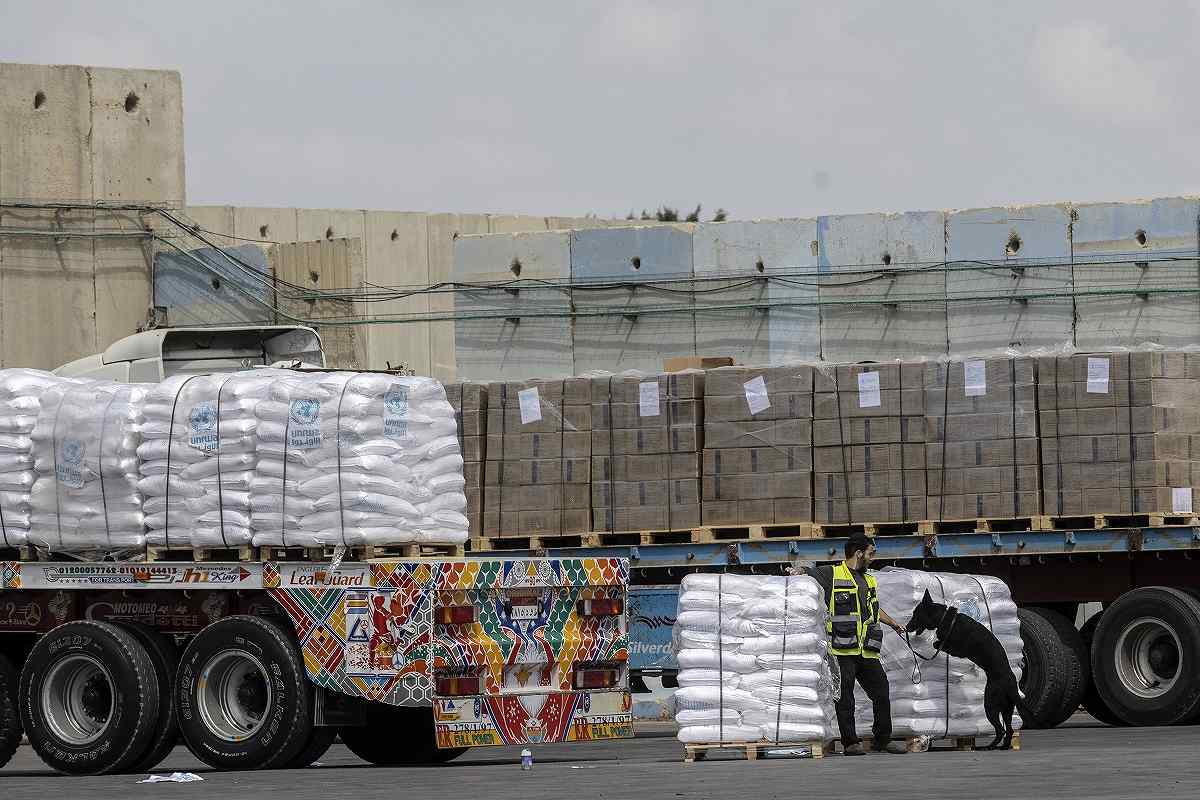
Trucks carrying humanitarian aid for the Gaza Strip pass through the Kerem Shalom Crossing in southern Israel in March.
11:06 JST, April 12, 2024
JERUSALEM – In the week since President Biden warned Israel to swiftly address civilian suffering in Gaza – or risk future U.S. support – Israeli officials have touted what they say is a record number of aid trucks entering the territory, one of several new measures that the government maintains will help alleviate the crisis.
But according to U.N. and other aid officials, as well as relief workers inside Gaza, little has actually changed on the ground – and aid access remains as complicated and risky as ever, even as much of the population hurtles toward famine.
Despite Israel’s emphasis on truck numbers – it says more than 1,200 trucks have crossed into Gaza over the last three days – the volume of aid hasn’t significantly increased, nor is it reaching those most in need. The government’s most concrete promises of reopening a crossing in northern Gaza, bringing bakeries back online and establishing clear channels to coordinate with aid workers also have yet to yield results.
“The proof in the pudding will be when it actually happens beyond words,” Jamie McGoldrick, the interim U.N. humanitarian coordinator for the Palestinian territories, said of the steps Israel pledged to take. “They are under pressure to deliver something.”
Biden’s ultimatum to Israel last week, delivered in a phone call with Prime Minister Benjamin Netanyahu, was spurred by the killing of seven World Central Kitchen workers by Israeli forces April 1, a reminder of the perilous environment in which relief agencies operate.
Six months into the conflict, which began when Hamas militants killed around 1,200 people in Israel and took 253 others hostage Oct. 7, the stakes for getting more food, medicine and other relief to Palestinians are those of life and death. More than 33,500 people have already been killed and over 76,000 injured, according to the Gaza Health Ministry, which does not distinguish between civilians and combatants but says the majority of the casualties are women and children.
Ninety-five percent of the population of 2.2 million is estimated to be experiencing crisis levels of hunger, and health authorities say at least 32 people had died of malnutrition or dehydration by early April. In northern Gaza, which the Israeli military has isolated from the rest of the enclave, famine may already be underway, the world’s leading body on food crises said last month.
Israeli officials have said they don’t want responsibility for Gaza and want to focus instead on the military campaign to eliminate Hamas. But growing U.S. pressure on Netanyahu to halt the worsening calamity prompted the prime minister to change course, according to an Israeli official who spoke on the condition of anonymity to discuss the high-level decision-making.
The White House last week said it would be watching for Israel to take “concrete, tangible steps” to significantly improve humanitarian access, with Biden describing the crisis in Gaza as “unacceptable.”
In response, McGoldrick’s office said Saturday, Israel committed to reopening the Erez Crossing in northern Gaza, restarting about 20 bakeries and repairing a major water line.
By Thursday, aid officials said, those plans had been discussed but were mostly not nearing fruition. Appearing to reverse course on opening Erez, which was heavily damaged in the Oct. 7 attack and only ever designed for foot passengers, Israel announced instead that it was building a new crossing to bring aid to the north.
This will help “gradually” boost the number of trucks entering Gaza overall to around 500 per day, said Rear Adm. Daniel Hagari, an Israeli military spokesman. That is the same number that sustained the enclave before the war, though swaths of Gaza’s agricultural land and farming capacity have been wiped out since then.
It was unclear when the new crossing would be built.
“Israel is surging aid into Gaza, with over 1200 trucks entering in 3 days (avg 400/day),” the Coordinator of Government Activities in the Territories (COGAT) posted Wednesday on X.
The agency, a branch of the Israeli military that coordinates aid in Gaza, was promoting the rising number of trucks that it says it inspects each day to enter the enclave’s border crossings. It blames the delays in aid distribution on the United Nations and other international agencies operating in Gaza. Israel has cited photographs of crateloads of aid apparently waiting to be distributed as evidence that humanitarian groups are not doing their jobs.
But the United Nations records only the trucks that physically enter Gaza in its database, and UNRWA, the U.N. agency for Palestinian refugees, tallied a lower figure for the same three-day period this week, at an average of 168 humanitarian trucks each day through the Rafah and Kerem Shalom crossings in the south.
Relief workers say Israeli regulations around access to the crossings mean they do not often have permission to reach the supplies that await them. COGAT did not respond to requests for comment on how it was addressing the obstacles cited by aid groups.
“It does not mean we have unfettered access to collect it,” an aid worker engaged in operations at the crossing said, speaking on the condition of anonymity due to the sensitivity of the issue. “Sometimes we only get partial access in the afternoon. Sometimes we only get a stab to collect the bulk of the aid in the morning. Sometimes, if there is fog or poor visibility in the corridor, we do not get access at all.”
At the same time, the inspection process remains onerous and opaque, officials say, and agencies often don’t know what type of aid they’re picking up until they reach the Gaza side of the terminal.
“Let’s say UNICEF has 10 trucks of medicine, 10 trucks of nutrition treatments. Once they’re in screening, we lose visibility,” said Tess Ingram, a spokeswoman for the U.N. children’s agency. “When we get to the receiving end, there might be one truck of medicine and one truck of nutrition, and then the next day maybe three trucks of something. It’s very difficult for us to plan on the other end because we have no visibility of what’s going to be spat out when.”
Trucks that enter Gaza from Egypt are sometimes only half-filled or have a smaller capacity than those used by the United Nations to collect and distribute aid – another reason the figures collected by aid groups and Israel’s military are often different.
“They might send in 300-plus trucks in a day, but we can’t get 300-plus trucks processed and out,” McGoldrick said.
Then aid groups must coordinate with the Israeli military for safe access to areas where civilians are most in need.
Food convoys traveling north are three times more likely to be denied permissions by Israel than any other humanitarian convoy, Jens Laerke, spokesman for the U.N. humanitarian office, said in a briefing Tuesday.
“When you put up statistics with numbers of truck going in saying, ‘Look at all these hundreds of trucks coming in,’ and you put it against how few trucks have actually moved around – well, it’s kind of an own goal, isn’t it?” he said. “Half of the convoys that we were trying to send to the north with food were denied by the very same Israeli authorities.”
McGoldrick said he was due to meet with representatives of the Israeli military’s Southern Command on Wednesday to discuss the establishment of a coordination cell that can deconflict movements of humanitarians on the battlefield and avoid further tragedies like the deaths of the WCK workers – one of Israel’s promises in the wake of the Biden call.
“We need a system that works,” McGoldrick said.
But 10 days after the WCK strike, aid workers themselves still fear being targeted. Around 200 relief workers have been killed in Gaza over the past six months.
UNICEF said one of its convoys was awaiting entry to northern Gaza on Tuesday when it was hit by gunfire that appeared to have originated from Israeli forces. The convoy was carrying 10,000 liters of fuel to power water and sanitation points, as well as nutrition and medical supplies intended for Kamal Adwan Hospital, which has reported that children there are dying of malnutrition and dehydration.
The agency’s armored car was hit three times as the group waited at a designated U.N. holding point along a route coordinated with Israeli forces, said Ingram, who was traveling with the convoy.
“We got three bullets in our car – two on my passenger door and one on the bonnet,” Ingram said.
After the shooting stopped, the group communicated what had happened to Israeli forces via UNRWA security personnel, she said. The Israeli military did not respond for request for comment about the incident.
“It’s clear that eight days after the World Central Kitchen tragedy, measures weren’t in place to prevent something like this from happening,” Ingram said.
"News Services" POPULAR ARTICLE
-

American Playwright Jeremy O. Harris Arrested in Japan on Alleged Drug Smuggling
-

Japan’s Nikkei Stock Average as JGB Yields, Yen Rise on Rate-Hike Bets
-

Japan’s Nikkei Stock Average Licks Wounds after Selloff Sparked by BOJ Hike Bets (UPDATE 1)
-

Japanese Bond Yields Zoom, Stocks Slide as Rate Hike Looms
-

Japan’s Nikkei Stock Average Buoyed by Stable Yen; SoftBank’s Slide Caps Gains (UPDATE 1)
JN ACCESS RANKING
-

Keidanren Chairman Yoshinobu Tsutsui Visits Kashiwazaki-Kariwa Nuclear Power Plant; Inspects New Emergency Safety System
-

Imports of Rare Earths from China Facing Delays, May Be Caused by Deterioration of Japan-China Relations
-

University of Tokyo Professor Discusses Japanese Economic Security in Interview Ahead of Forum
-

Japan Pulls out of Vietnam Nuclear Project, Complicating Hanoi’s Power Plans
-

Govt Aims to Expand NISA Program Lineup, Abolish Age Restriction

























